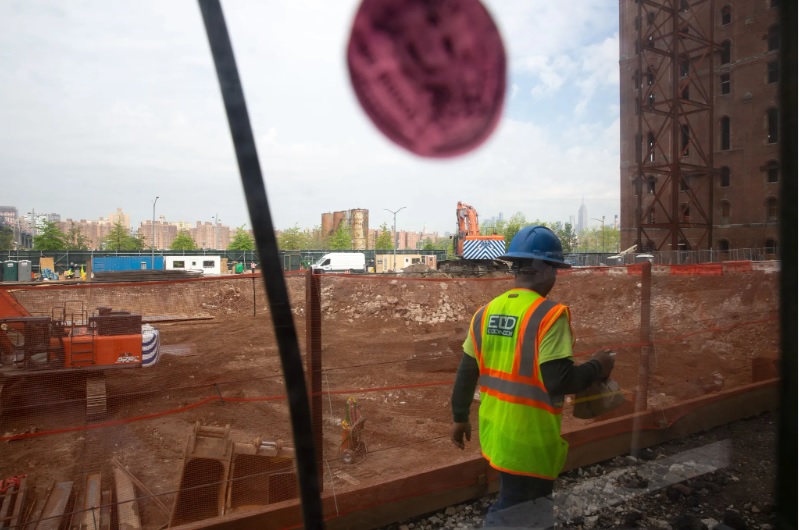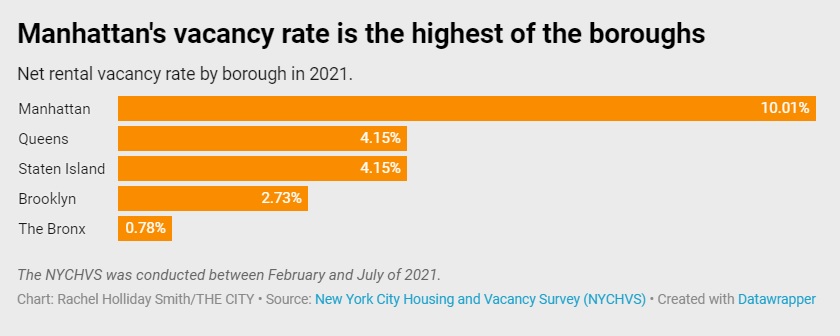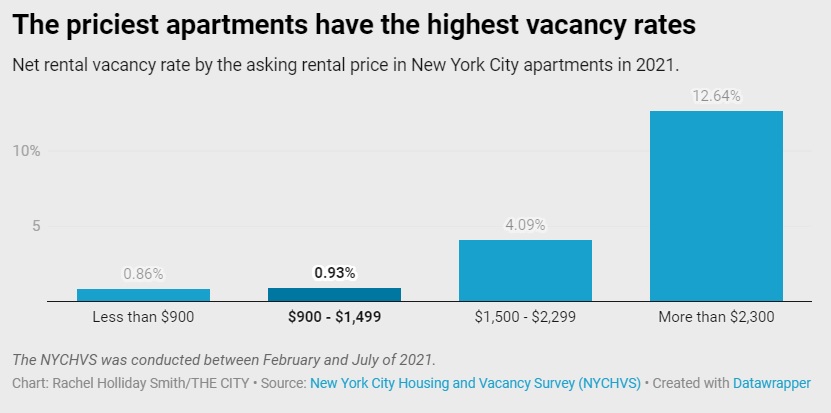
New construction goes up in Hell’s Kitchen, Manhattan, March 16, 2022. Manhattan had the highest vacancy rate out of the five boroughs. Ben Fractenberg/THE CITY

This article was originally published by The CITY on May 17
New York City has more vacant apartments overall than it did five years ago even as units with monthly rents under $1,500 have dried up, according to a new report that also shows maintenance issues are surging across the board.
The highly anticipated 2021 Housing and Vacancy Survey (HVS) arrived a year late on Tuesday, delayed by the pandemic. A 91-page summary analysis of the report from the city Department of Housing Preservation and Development paints a vivid picture of the rental landscape across the five boroughs, the places where renters live — and what they can afford.
The survey has been conducted by the U.S. Census Bureau on behalf of the city’s housing department every three years since 1965. This latest survey took place between February and July of 2021.
Here are the highlights from the findings:
Vacancy Rate Is Up — But Rent Regulation Is Still Safe
The report found that 4.54% of all New York apartments are vacant as of 2021. That’s up from 3.63% in 2017, the last time the survey was completed.
That figure is critical to rent regulation in New York. The law underpinning regulated apartments is premised on a “housing emergency,” defined by a vacancy rate below 5%.
During the pandemic’s early months, lawmakers and landlord groups mobilized to address the possibility that an emptying city would push the vacancy rate above that 5% threshold.
But that has not happened yet, the survey shows, and the .46% we still have left to go is enough to continue New York’s “housing emergency.”
The vacancy rate varied widely by borough, however, with Manhattan’s rate climbing above 10%. The Bronx has the lowest rate at 0.78%.
Jay Martin, executive director of the Community Housing Improvement Program, an association of property owners, said the survey is evidence to him that New York’s officials are “actively trying to depress the creation and preservation of needed housing with bad policies,” he said in a statement.
CHIP has taken the city to court over tougher rent stabilization laws state lawmakers imposed in 2019, one suit in a pair challenging the constitutionality of New York’s rent laws now before the federal Court of Appeals for the Second Circuit.
Low-Cost Apartments Are Getting Harder to Find
Many indicators in the survey show a continuing crunch at the lower end of the market.
Low-cost apartments are disappearing while more high-price units are being created, the HVS shows. Between 2017 and 2021, the city lost 96,000 units with rents less than $1,500. At the same time, the city gained 107,000 units with rents of $2,300 or higher.
The median asking rent for all vacant apartments was $2,750 last year, up 46% from $1,875 in 2017. To be able to afford that median vacant rent, a potential household would have to earn at least $110,000, the HVS found.
The number of renters paying a huge chunk of their income in rent is also high. In 2021, more than half of renters — or just under 1 million households — paid more than 30% of their income toward rent, the survey showed. A third of all households directed more than 50% of their income towards housing, which makes them “severely rent burdened” according to the HVS.
The affordability crisis is on clear display in the vacancy rates as well. Vacant apartments are incredibly rare among the lowest rental prices, while reaching north of 12% for apartments priced above $2,300 per month, the survey shows.
Matthew Murphy, executive director at the NYU Furman Center, a real estate policy think tank, said renters’ issues follow trends that have been building through the 1990s, 2000s and 2010s, even as the city has created more housing.
While many factors contribute to the crunch, including deregulation of apartments under pre-2019 rent laws, and the addition of higher-end apartments to the overall pool of housing, for him it boils down to the decades-long draw of New York City as a place people want to live.
“You just can’t escape that,” he said. In his view, the data shows that even the pandemic hasn’t dampened it.
“It still didn’t fundamentally change the intense demand to live here, and the high cost people are willing to pay,” he said.
Rodents, Cracks and Lack of Heat
The survey also looked at maintenance issues in apartments citywide and, this time around, they found a decrease in the quality and upkeep of practically all units, no matter whether they were rent-regulated, market-rate or in public housing.
Heating issues are up since 2017, as are the presence of rodents, cracks or holes in walls, broken plaster or peeling paint and leaks. Happily, toilet breakdowns are trending down.
Maintenance issues vary widely by borough. People in The Bronx reported the most problems, with 32% of occupied units reporting one or two problems and 27% reported three or more. Staten Islanders had the fewest maintenance issues, with 25% reporting one or two problems and just 4% reporting three or more.
An Imperfect Picture on Pieds-à-Terre
The survey gave some indication of how many homes in New York are vacant but not up for sale or for rent. A big chunk of those apartments are used only seasonally, recreationally or on an occasional basis, the survey found.
More than 353,000 units were vacant but unavailable in 2021, up from 248,000 in 2017. Some were undergoing renovation, uninhabitable, or caught in a legal dispute.

Construction workers at a soon-to-be residential building along Kent Avenue in Williamsburg, May 16, 2022.Ben Fractenberg/THE CITY
But the most common reason they were off the market were due to being “held for seasonal, recreational, or occasional use,” the survey read. Nearly 103,000 units fell into that category — up from 74,950 in 2017.
Murphy of the Furman Center cautioned, however, that those figures may not represent the universe of people who use a pieds-à-terre, or a situation where someone is using an apartment for short-term rentals.
“If somebody is a really active pied-à-terre user, like a weekend commuter type of person, they would never be registered as a vacant unit,” he said. “It’s very difficult to tell anything about Airbnb or pieds-à-terre in the HVS.”
Notably, those “occasional use” units do not include people who relocated temporarily due to the pandemic. For the 2021 survey, workers classified those homes as “occupied” and conducted their interviews with individuals where they had relocated, according to the survey methodology.
THE CITY is an independent, nonprofit news outlet dedicated to hard-hitting reporting that serves the people of New York.








